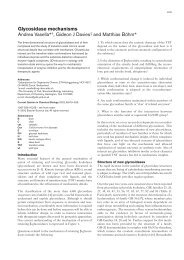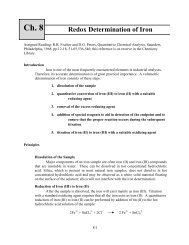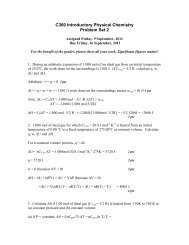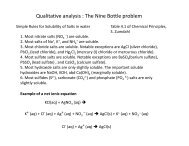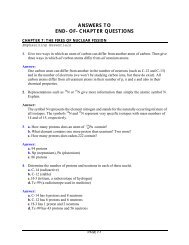ANSWERS TO END-OF-CHAPTER QUESTIONS
ANSWERS TO END-OF-CHAPTER QUESTIONS
ANSWERS TO END-OF-CHAPTER QUESTIONS
You also want an ePaper? Increase the reach of your titles
YUMPU automatically turns print PDFs into web optimized ePapers that Google loves.
Oxidation half-reaction:<br />
__CH4(g) + __OH – (aq) ⎯→ __CO2(g) + __H2O(l) + __e –<br />
Reduction half-reaction:<br />
__O2(g) + __H2O(l) + __e – ⎯→ __OH – (aq)<br />
Answer:<br />
Oxidation half-reaction:<br />
CH4(g) + 8 OH – (aq) ⎯→ CO2(g) + 6 H2O(l) + 8 e –<br />
Reduction half-reaction:<br />
2 O2(g) + 4 H2O(l) + 8 e – ⎯→ 8 OH – (aq)<br />
Overall reaction:<br />
CH4(g) + 2 O2(g) ⎯→ CO2(g) + 2 H2O(l)<br />
19. The reactions in a hydrogen-fueled solid oxide fuel cell (S<strong>OF</strong>C) are shown in equations<br />
8.19–8.21. This is the skeleton equation for the oxidation half-reaction if CO, rather than H2,<br />
is the fuel.<br />
a. Balance by adding electrons as needed.<br />
b. Combine the balanced equation for oxidation with that for reduction.<br />
c. Write the overall equation for a carbon monoxide-based S<strong>OF</strong>C.<br />
Answer:<br />
The reactions in a hydrogen-fueled solid oxide fuel cell (S<strong>OF</strong>C) are shown in equations<br />
8.19–8.21.<br />
a. CO(g) + O 2– ⎯→ CO2(g) + 2 e –<br />
b. The reduction half reaction is: ½ O2(g) + 2 e – ⎯→ O 2–<br />
Combined, this gives: CO(g) + O 2– + ½ O2(g) + 2 e – ⎯→ CO2(g) + 2 e – + O 2–<br />
c. CO(g) + ½ O2(g) ⎯→ CO2(g)<br />
20. a. Potassium, a Group 1A metal, reacts with H2 to form potassium hydride, KH. Write the<br />
chemical equation for the reaction.<br />
b. Potassium hydride reacts with water to release H2 and form potassium hydroxide. Write<br />
the chemical equation.<br />
c. Offer a possible reason that potassium is not used to store H2 for use in fuel cells.<br />
Answer:<br />
a. K(s) + ½ H2(g) ⎯→ 2 KH(s)<br />
b. KH(s) + H2O(l) ⎯→ H2(g) + KOH(s)<br />
c. Potassium is a highly reactive metal that can react explosively with water. The risks would<br />
outweigh the benefits.<br />
PAGE 8-6



